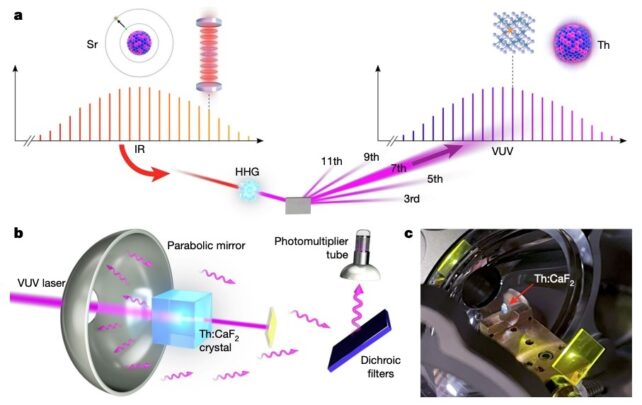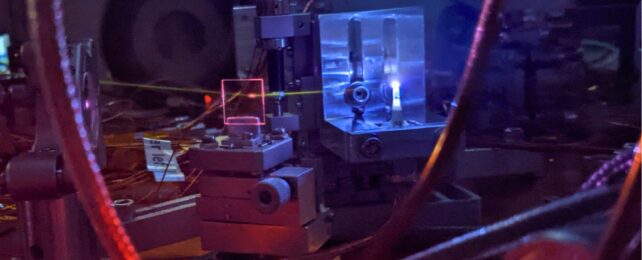A huge breakthrough decades in the making was made just a few months ago, and already scientists are realizing its potential: A measurement of the gap between the quantum energy states of a thorium nucleus has been used to create the very first, rudimentary nuclear clock.
By coupling a strontium atomic clock with a crystal containing thorium nuclei, a team of physicists has successfully demonstrated the core technology that will lead us to the first fully realized and developed nuclear clock.
That milestone – still yet to be reached – will open up a whole new realm of ultra-precise timekeeping.
"With this first prototype, we have proven: Thorium can be used as a timekeeper for ultra-high-precision measurements," explains physicist Thorsten Strumm of the Vienna University of Technology.
"All that is left to do is technical development work, with no more major obstacles to be expected."
An atomic clock is one that relies on the very precise 'ticking' of atoms as they switch between energy states when stimulated by a laser, as determined by the states of the electrons that whirl about the nucleus at the atomic core.
This is a lot more difficult to achieve with the nucleus itself, however, since it takes a lot more energy to shift its energy state than it does to change the energy state of electrons.
A nuclear clock is highly desirable, though, since it would be a lot more stable and precise than an atomic clock. In turn, a nuclear clock would enable more precise measurements of the physical Universe – which has implications for everything from navigation to the search for dark matter.
A measurement of the energy jump – the difference between the energy states – of a thorium nucleus was announced earlier this year. And this has allowed Strumm and his colleagues to determine the precise energy required to create the change in energy states, the mechanism on which a nuclear clock would tick.
The next step was to demonstrate that they could create a clock from this ticking, and this is what Strumm and his colleagues have now done.
The clock they demonstrated is not the full nuclear clock experience, but the first steps in that direction. The strontium clock at JILA at the National Institute of Standards & Technology is operated using infrared light.
The team created a small calcium fluoride crystal containing thorium nuclei, the energy states of which are switched using vacuum ultraviolet light.

To couple the crystal to the atomic clock, the researchers needed to find a way to convert the infrared light to ultraviolet. They did this by creating a frequency comb of infrared wavelengths, and running it through xenon gas, which interacts with the infrared light to emit ultraviolet wavelengths.
The result was a combined frequency comb that could excite the transition of the thorium nuclei and synchronize it with the ticking of the strontium atoms.
The resulting nuclear ticking isn't any more precise than the strontium atomic clock, but now that the core concept has been demonstrated, the actual technology is in sight – and very close to full realization, the researchers say.
"Imagine a wristwatch that wouldn't lose a second even if you left it running for billions of years. While we're not quite there yet, this research brings us closer to that level of precision," says physicist Jun Ye of JILA.
The team ran their experiment many times; each time, they achieved results consistent with an atomic clock. The next step will be to refine it.
"When we excited the transition for the first time, we were able to determine the frequency to within a few gigahertz. That was already more than a factor of a thousand better than anything known before. Now, however, we have precision in the kilohertz range – which is again a million times better," Schumm says.
"That way, we expect to overtake the best atomic clocks in 2-3 years."
The research has been published in Nature.
